
Dell XPS is a line of consumer-oriented laptop and desktop computers manufactured by Dell since 1993.

ThinkCentre is a brand for a family of business-oriented desktop computers, the early models of which were designed, developed and marketed by International Business Machines (IBM) since 2003. In 2005, IBM sold its PC business, including the ThinkCentre brand, to Lenovo. ThinkCentre computers typically include mid-range to high-end processors, options for discrete graphics cards, and multi-monitor support.

Dell Vostro is a line of business-oriented laptop and desktop computers manufactured by Dell aimed at small to medium range businesses. From 2013–2015, the line was temporarily discontinued on some Dell websites but continued to be offered in other markets, such as Malaysia and India.
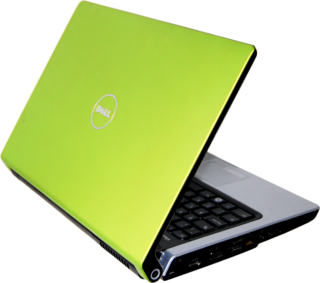
Dell Studio was a range of laptops and desktops targeted at the mainstream consumer market, produced by Dell. The computers sat above Dell's Inspiron and below the XPS consumer lines in terms of price and specifications. They differed from Dell's lower-end Inspiron models by offering slot-loading optical drives, media keys, more cover design options, faster processor options, HDMI and eSATA ports, LED-backlit screens, and backlit keyboards.

The ThinkPad X series is a line of notebook computers and convertible tablets produced by Lenovo as part of the ThinkPad family. The ThinkPad X series is traditionally the range best designed for mobile use, with ultraportable sizes and less power compared to the flagship ThinkPad T series. It was initially produced by IBM until 2005.

The ThinkPad W series laptops from Lenovo were described by the manufacturer as being "mobile workstations", and suit that description by being physically on the larger side of the laptop spectrum, with screens ranging from 15.6" to 17.3" in size. Most W series laptops offered high-end quad-core Intel Core processors with an integrated GPU as well as an Nvidia Quadro discrete GPU, utilizing Nvidia Optimus to switch between the two GPUs as required. Notable exceptions are the W500, which has ATI Mobility FireGL integrated workstation-class graphics, and the W550s, which is an Ultrabook-specification laptop with only a dual-core processor. The W series laptops offered independent software vendor (ISV) certifications from various vendors such as Adobe Systems and Autodesk for computer-aided design (CAD) and 3D modeling software.

The IdeaPad S Series is a series of notebook computers launched by Lenovo in October 2008. The IdeaPad S10 was initially scheduled for launch in September, but its release was delayed in the United States until October.
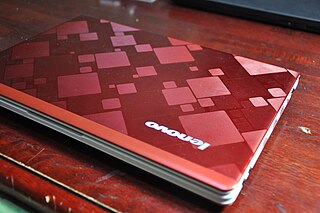
The first laptop in the IdeaPad U series was the U110 launched in 2008 by Lenovo. Showcased at CES 2008, the laptop also launched the IdeaPad series itself, and received the Best of CES 2008 award. The IdeaPad U series was a line of Lenovo's consumer line of laptops, combining Lenovo's traditional engineering with design changes that were significantly different from ThinkPad products.
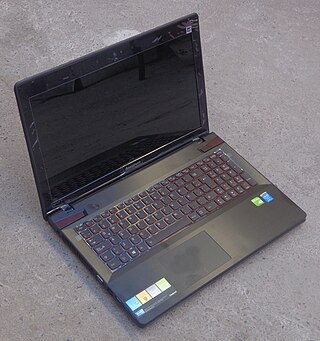
The IdeaPad Y series was a consumer range of laptops produced by Lenovo, first announced in 2008. They were marketed as premium high performance laptops for multimedia and gaming, as part of the IdeaPad line.
The A Series desktops are part of Lenovo’s ThinkCentre product line. Formerly an IBM brand, Lenovo acquired the ThinkCentre desktop brand following its purchase of IBM’s Personal Computing Division (PCD) in 2005. The first desktop in the A Series was the ThinkCentre A50p. Lenovo has released A Series desktops in multiple form factors, ranging from traditional tower, to small form factor, and all-in-ones (AIOs).
Lenovo's IdeaCentre A Series is a line of all-in-one desktops designed primarily for home use and the consumer PC segment. The sections below describe the IdeaCentre A Series desktops, categorized by their year of release.
The IdeaCentre B Series all-in-one desktops from Lenovo were first launched in 2010. Like other desktops in the IdeaCentre product line, the B Series desktops were designed for home users, with a focus on the consumer PC segment. The first model in the series was the B500.
The Lenovo IdeaCentre Q series are a line of nettop computers meant primarily for home and personal use. The Q Series nettops are described by the manufacturer as being multimedia-oriented nettops. Comparing the size to a typical paperback book, Lenovo describes the Q Series nettops as the smallest desktops in production. The general features of the Q Series desktops are the small size, low energy requirements, ability to play HD video, and low noise levels.
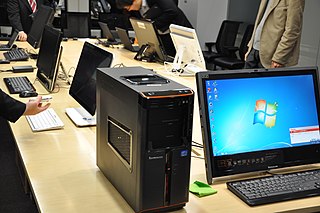
The Lenovo IdeaCentre is a line of consumer-oriented desktop computers designed, developed and marketed by Lenovo. The first IdeaCentre desktop, the IdeaCentre K210, was announced by Lenovo on June 30, 2008 as a consumer-focussed alternative to the business-oriented ThinkCentre and ThinkStation brandnames acquired from IBM. While the IdeaCentre line consists entirely of desktops, they share a common design language with the IdeaPad line of laptops and hybrids. One such feature is Veriface facial recognition technology.
IdeaCentre K series is a family of gaming-oriented desktops manufactured by Lenovo. Typical features on the desktops include mid-range to high-end processors, discrete graphics cards, multiple hard disk drives, multiple RAM DIMMS, multiple USB ports, and multiple optical disk drives. The K Series desktops also come with a physical switch on the CPU that allows users to shift between different levels of processing power. For example, the K330 offered red for high performance, blue for moderate performance, and green for less processing- and resource-intensive tasks.
In addition to the ThinkPad and IdeaPad laptops, Lenovo also offers a value-priced series of laptops. Called ‘Essential’ on the Lenovo website, the products available in this line include the G Series, B Series, and V Series. Launched in 2009, the first laptop in the Essential range was the G530.
Lenovo's line of Essential desktops is a collection of budget-conscious machines designed for consumers, and advertised as being "affordable, space saving, and energy efficient". The Essential desktop line is different from both Lenovo's ThinkCentre line and Lenovo's IdeaCentre line. Lenovo defines its ThinkCentre desktops as business-oriented computers, while the IdeaCentre desktops are meant primarily for entertainment. The Essential range of desktops can be categorized as being between the two – meant more for ordinary everyday use.

ThinkStation is a brand of professional workstations from Lenovo announced in November 2007 and then released in January 2008. They are designed to be used for high-end computing and computer-aided design (CAD) tasks and primarily compete with other enterprise workstation lines, such as Dell's Precision, HP's Z line, Acer's Veriton K series, and Apple's Mac Pro line.
ThinkSystem is a family of Intel and AMD servers from Lenovo. The line began as the ThinkServer with the TS100 in 2008. The ThinkServer family has been discontinued in 2019, and the new family of Intel servers is named ThinkSystem.
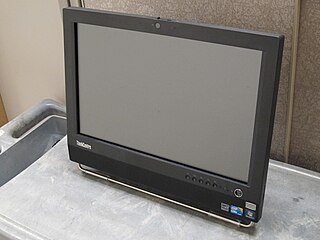
The ThinkCentre Edge is a series of desktop computers from Lenovo, designed primarily for home offices and small businesses. The product series features desktops in both tower and All-in-One form factors, designed to save up to 70% desk space as compared to traditional tower desktop PCs.











